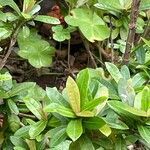Annual or short-lived perennial herb; stems erect, stout, fleshy, glabrous, to 1 m tall, often from a woody root. Leaves alternate, often deciduous in the dry season; petiole to ca. 1 cm long; blade fleshy, oblanceolate to obovate, 2-14 x 0.6-4.5 cm, usually rounded or emarginate at apex, attenuate or cuneate at base, glabrous. Inflorescence a few-to many-flowered raceme or subcorymbose cyme, to 7(-19) cm long; pedicels 3-angled, 7-11 mm long, mostly ascending. Sepals pinkish-green, free, suborbicular, broadly ovate or lance-ovate, 5-7 mm long, cuspidate, persistent; petals white, pink or purple, obovate, broadly elliptical or ovate, 6-14 x 6 mm; stamens 20-40, filaments 4-5 mm long, anthers 0.8-1 mm long; ovary subglobose, ca. 1.5 mm wide. Fruit globose or subglobose, 4-6 mm wide; seeds flattened-orbicular, ca. 1 mm wide, black, shining, striolulate in concentric rows.
More
A small leafy branching herb. It grows up to 35-60 cm high. It can be erect or lie over. The roots are swollen and fleshy. The stems are succulent. The leaves are alternate and have very short stalks and are fairly soft and light green in colour. The leaves can be 7.5 cm long. In the shade they grow larger. The flowers are on a 3 sided stalk at the top of the plant. There is a clump of pale pink flowers with 5 petals. Seeds are very small and black.
A tropical plant. It occurs in coastal tropical areas and up to about 1,600 m altitude. Due to the C4 pathway optimum growth is achieved with high temperatures, high soil fertility, plenty of sunlight and sufficient moisture. The plant will also grow adequately in poorer conditions including some drought and a little shade. It can grow in arid places.
More
Occurs naturally on roadsides, waste places, and forests edges, from sea level up to 1,000 metres.
The leaves and tender stems are eaten raw or cooked. They are slightly sour. Steaming the leaves produces less brown discolouration and they are less slimy. They can also be dried and stored. They are used in soup. Caution: Due to oxalates in the leaves, large amounts should not be eaten. They can be removed by cooking and leaching. Also fermentation, steaming and baking. It is good to use in soups.
More
Use: In Guyana and Suriname sometimes cultivated as a vegetable (Ostendorf, 1962).
It can be grown from seeds or stem cuttings. There are about 4000 seeds per gram. Seed collection is not easy because the seed capsules split open very easily and the seeds drop out. Also plants don't always produce seeds readily. Growing from seed is easiest by sowing seeds in a small nursery then transplanting the small plants when they are about 5-8 cm high. With very small seeds like these, it is best to mix the seeds with dry sand before sowing. Then a small amount of the seed/sand mixture can be sown and the seeds will not be too close together. Seeds will grow in about 6 days. Often plants once established become self sown from natural seed falling. Alternatively cuttings about 15 cm long of the more mature but not woody stems can be used. The excess leaves should be removed from the cuttings. A spacing of 20 cm is suitable. Plants grow better in fertile soil, but will grow in fairly low fertility soils. They need plenty of moisture.






